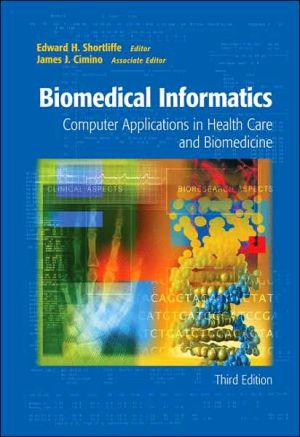Biopsy Interpretation of the Prostate
The revised Fourth Edition of this highly acclaimed reference is a practical, state-of-the-art, superbly illustrated guide to the evaluation and clinical correlates of prostate biopsy findings. This edition features expanded coverage of mimickers of prostate cancer, a new chapter on immunohistochemistry and molecular techniques, a major update to the Gleason grading system, new information on histologic changes following radiation therapy, and an expanded section on tumors of specialized...
Search in google:
The revised Fourth Edition of this highly acclaimed reference is a practical, state-of-the-art, superbly illustrated guide to the evaluation and clinical correlates of prostate biopsy findings. This edition features expanded coverage of mimickers of prostate cancer, a new chapter on immunohistochemistry and molecular techniques, a major update to the Gleason grading system, new information on histologic changes following radiation therapy, and an expanded section on tumors of specialized prostatic stroma. The book contains nearly 300 full-color illustrations.A companion online image bank provides over 1,800 full-color images of specimens at various magnifications, plus a question-and-answer review of prostate pathology. Doody Review Services Reviewer:Anamarija M Perry, MD(University of Cincinnati College of Medicine)Description:This is the fourth edition of a book in the Biopsy Interpretation series that comprehensively covers prostate pathology and interpretation of prostate biopsy specimens. This edition is significantly expanded and updated over the third, published in 2002, and some chapters have been extensively modified.Purpose:It is written as a guide for surgical pathologists interpreting and reporting prostate biopsies. It covers systematically the entire pathology of the prostate with a special emphasis on important differential diagnoses. Use of immunohistochemical techniques in the diagnosis of prostate cancer, along with their limitations and potential pitfalls, is also included.Audience:This book will be of interest to all pathologists who evaluate biopsy material from the prostate. It will be also useful to pathology residents and fellows. Certain chapters, especially on reporting prostatic cancer and biomarkers for the detection and management of prostate carcinoma, will be useful to all clinicians involved in the treatment of patients with prostate cancer.Features:The first two chapters deal with clinical correlates with prostate biopsy and biopsy techniques and the third chapter covers gross anatomy and normal histology of the prostate. Inflammatory conditions, prostatic intraepithelial neoplasia, and mimickers of prostatic adenocarcinoma are covered in separate chapters. Chapters on reporting of prostate cancer and grading are also included. Different histologic variants of prostate cancer, as well as urothelial carcinoma, mesenchymal tumors, rare tumors, and prostatic urethral lesions are covered. A separate chapter covers therapy-induced changes in the prostate. The last chapter covers biomarkers for the detection and management of prostate cancer. This edition increases the number of images and all of them are now in color. Throughout the book, greater use is made of tables for the differential diagnosis of prostate cancer and its mimickers. The chapter on prostatic intraepithelial neoplasia and its mimickers is updated to provide new recommendations for follow-up. The chapter on the diagnosis of limited adenocarcinoma of the prostate is totally reworked to provide a methodical approach to the diagnosis of cancer on biopsies using architectural, cytological, and ancillary features. A new expanded section on the use of immmunohistochemistry for the diagnosis of prostate cancer has been added. The chapter on grading of prostatic adenocarcinomas is rewritten to cover the New Consensus on the Updating of Gleason grading system. Recently described entities such as intraductal carcinoma and PIN-like ductal adenocarcinoma are discussed. A chapter on emerging biomarkers for the detection and management of prostate cancer provides readers with the latest array of molecular markers that may be used in the near future as adjuncts to currently established prognostic parameters. The book is well illustrated and the quality of the images is excellent. Numerous tables cover differential diagnosis and immunohistochemical features of different benign and malignant lesions in the prostate. In addition, an interactive web site with an image bank and test bank with multiple choice questions complements the book. Assessment:This is an extremely helpful book for pathologists and pathologists in training who evaluate prostate biopsies. It should be widely distributed to pathology departments. The entire field of prostate pathology is covered in a concise, yet comprehensive manner. The book is a great quick reference and very helpful tool for the everyday work of a surgical pathologist. Among the strongest features of the book are the numerous tables that deal with differential diagnoses of prostate cancer versus benign conditions. The book is well illustrated with numerous excellent images that complement the text. In the sometimes confusing area of prostate pathology, this book will help you to interpret and report prostate biopsy in a modern, up-to-date, and patient-oriented way.
Preface to the First Edition viiiPreface xClinical Correlates with Biopsy 1Needle Biopsy Technique 6Gross Anatomy and Normal Histology 13Inflammatory Conditions 22Prostatic Intraepithelial Neoplasia and Its Mimickers 55Diagnosis of Limited Adenocarcinoma 72Mimickers of Adenocarcinoma of the Prostate 105Reporting Cancer: Influence on Prognosis and Treatment 157Grading of Prostatic Adenocarcinomas 175Findings of Atypical Glands Suspicious for Cancer 203Prostatic Duct Adenocarcinoma 218Neuroendocrine Differentiation in the Benign and Malignant Prostate 228Mucinous Differentiation in the Benign and Malignant Prostate 238Benign and Malignant Prostate Following Treatment 246Urothelial Carcinoma 262Mesenchymal Tumors and Tumor-like Conditions 275Miscellaneous Benign and Malignant Lesions 296Prostatic Urethral Lesions 318Emerging Biomarkers for the Detection and Management of Prostate Carcinoma 330Macros 340Index 346
\ From The CriticsReviewer: Anamarija M Perry, MD(University of Nebraska Medical Center)\ Description: This is the fourth edition of a book in the Biopsy Interpretation series that comprehensively covers prostate pathology and interpretation of prostate biopsy specimens. This edition is significantly expanded and updated over the third, published in 2002, and some chapters have been extensively modified.\ Purpose: It is written as a guide for surgical pathologists interpreting and reporting prostate biopsies. It covers systematically the entire pathology of the prostate with a special emphasis on important differential diagnoses. Use of immunohistochemical techniques in the diagnosis of prostate cancer, along with their limitations and potential pitfalls, is also included.\ Audience: This book will be of interest to all pathologists who evaluate biopsy material from the prostate. It will be also useful to pathology residents and fellows. Certain chapters, especially on reporting prostatic cancer and biomarkers for the detection and management of prostate carcinoma, will be useful to all clinicians involved in the treatment of patients with prostate cancer.\ Features: The first two chapters deal with clinical correlates with prostate biopsy and biopsy techniques and the third chapter covers gross anatomy and normal histology of the prostate. Inflammatory conditions, prostatic intraepithelial neoplasia, and mimickers of prostatic adenocarcinoma are covered in separate chapters. Chapters on reporting of prostate cancer and grading are also included. Different histologic variants of prostate cancer, as well as urothelial carcinoma, mesenchymal tumors, rare tumors, and prostatic urethral lesions are covered. A separate chapter covers therapy-induced changes in the prostate. The last chapter covers biomarkers for the detection and management of prostate cancer. This edition increases the number of images and all of them are now in color. Throughout the book, greater use is made of tables for the differential diagnosis of prostate cancer and its mimickers. The chapter on prostatic intraepithelial neoplasia and its mimickers is updated to provide new recommendations for follow-up. The chapter on the diagnosis of limited adenocarcinoma of the prostate is totally reworked to provide a methodical approach to the diagnosis of cancer on biopsies using architectural, cytological, and ancillary features. A new expanded section on the use of immmunohistochemistry for the diagnosis of prostate cancer has been added. The chapter on grading of prostatic adenocarcinomas is rewritten to cover the New Consensus on the Updating of Gleason grading system. Recently described entities such as intraductal carcinoma and PIN-like ductal adenocarcinoma are discussed. A chapter on emerging biomarkers for the detection and management of prostate cancer provides readers with the latest array of molecular markers that may be used in the near future as adjuncts to currently established prognostic parameters. The book is well illustrated and the quality of the images is excellent. Numerous tables cover differential diagnosis and immunohistochemical features of different benign and malignant lesions in the prostate. In addition, an interactive web site with an image bank and test bank with multiple choice questions complements the book. \ Assessment: This is an extremely helpful book for pathologists and pathologists in training who evaluate prostate biopsies. It should be widely distributed to pathology departments. The entire field of prostate pathology is covered in a concise, yet comprehensive manner. The book is a great quick reference and very helpful tool for the everyday work of a surgical pathologist. Among the strongest features of the book are the numerous tables that deal with differential diagnoses of prostate cancer versus benign conditions. The book is well illustrated with numerous excellent images that complement the text. In the sometimes confusing area of prostate pathology, this book will help you to interpret and report prostate biopsy in a modern, up-to-date, and patient-oriented way.\ \








